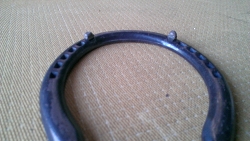Much of the summer and fall, horses are racing on different tracks from one race to the next. Racetrack surfaces can vary greatly, requiring shoe changes.
Sometimes two tracks that you think should be alike will fool you. For example – two limestone one-mile tracks are not necessarily going to be equal. Experienced trainers have raced all over North America and have learned the tendencies of each track. This knowledge is invaluable when shipping a horse to a certain track for the first time in order to compete in a big race.
Other variables, such as the weather and decisions of the person in charge of track maintenance, can have a huge effect on racing conditions from week to week at the same racetrack. This is why it is nice to have options when your horse is warming up for a race, especially if it’s a stakes race on unfamiliar turf.
One of the easiest things to do is to add borium nails to the shoe. This can be done without even removing the shoe from the horse’s hoof. Borium is a very hard material that is normally welded onto a steel shoe by the farrier when that shoe is made. Borium is put on the shoe in various ways to create more traction, and/or wear resistance.
Many years ago, John Patterson Sr. used to ask me to make borium nails. This was done by welding the borium onto the head of a horseshoe nail, which is no small task. (Actually, it is a small task, considering the size of a nail head. Now horseshoe nails can be purchased with the borium already on the nailhead. Whew!)
Patterson had a very nice open trotter named First Down. When training in Lexington, First Down needed no extra traction on his front shoes. If he were to race on another track or if conditions at The Red Mile required, the trainer would simply remove the front two nails of each front shoe and replace them with borium nails that I had made. This was the early version of removable studs.
 A shoe with borium inserted in the toe to allow for more traction.
A shoe with borium inserted in the toe to allow for more traction.
When the race was over, we just pulled the borium nails back out and put in the normal ones. Patterson could--and often did--shoe horses himself so changing the nails was an easy task.
Trainer Anette Lorentzon did the same thing very successfully this past spring when racing at Hoosier Park.
If you are not comfortable with putting nails into a horse’s hoof, it is a simple task for any paddock blacksmith. Just make sure you have the borium nails with you.
Another race-time adjustment could be changing or removing the shoes. If you’ve raced your horse in different types of shoes (and most have toward late summer), have those others with you. No matter what type of shoe the horse races in, it is always practical to have an extra set with you when shipping to a race.
It’s always great when the trainer or handler knows how to put on a shoe. I am reasonably certain any horseman who cannot tack on a shoe wished he could at one time or another, usually on a race day.
It is also advantageous for a farrier to be able to train or jog a horse, if for no other reason than to see what the trainer is trying to describe when attempting to help a horse through shoeing. That is not to say we farriers should drive in races. I did so for a brief period. That requires a different kind of race-time adjustment: the catch-driver!
Veteran Standardbred farrier Steve Stanley of Lexington, Ky., authors a monthly column for Hoof Beats, the official harness racing publication of the U.S. Trotting Association. The American Farriers Journal Editorial Advisory Board member offers plenty of practical advice that will be of special interest regardless of the type of horses that you work with. Click here to read more from Steve Stanley's Hoof Beats series.








Post a comment
Report Abusive Comment